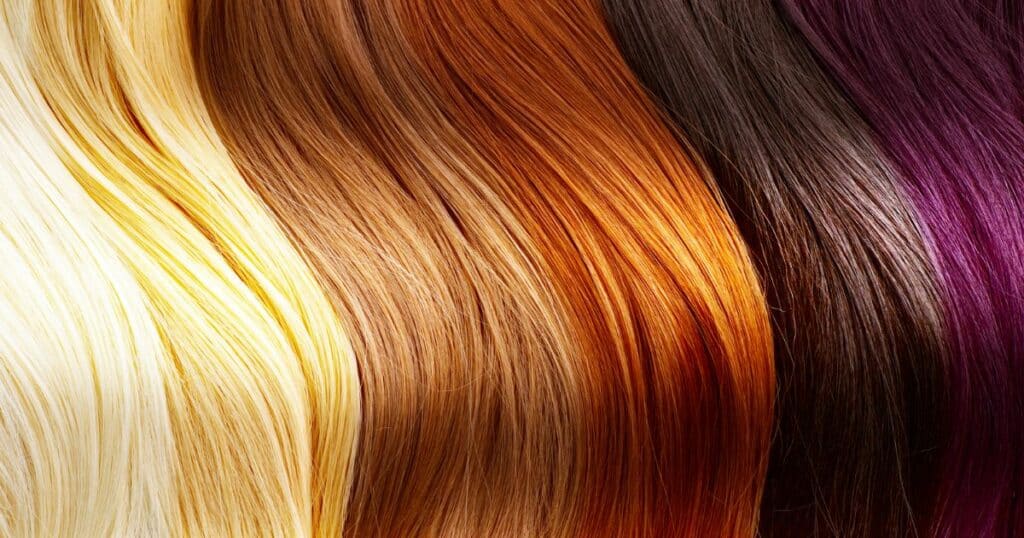Hair color is a versatile and transformative beauty tool that allows individuals to express themselves and achieve a fresh new look. Whether you’re looking to cover grays, enhance your natural shade, or make a bold color statement, understanding the nuances of hair color is critical to finding the perfect hue for your locks. From subtle highlights to permanent color, the hair dye market offers an array of options, as well as various application techniques and color formulas that cater to specific needs and preferences.
Navigating the world of hair color can be an overwhelming task for beginners, especially with the ever-growing list of terms and techniques. Virtual hair color tools have emerged as an innovative solution to help individuals explore different shades and styles in a risk-free environment before committing to a color change. Pairing this digital exploration with expert guidance from professional stylists ensures that you achieve the desired results while maintaining the health of your hair.
Key Takeaways
- Exploring hair color options requires understanding various techniques and color formulas.
- Virtual hair color tools enable risk-free experimentation before committing to a change.
- Expert guidance is crucial for achieving desired results and maintaining hair health.

Understanding Hair Color
The Basics
Hair color is a complex subject, with various shades, depths, and tones. From reds to blondes, brunettes to black, and even cool silver or copper hair colors, understanding the intricacies of hair color can be challenging. However, by breaking down the components and learning the terminology, it becomes easier to navigate the world of hair color.
First, it is essential to understand that hair comprises three layers: the outer cuticle, the cortex, which comprises the body of the hair shaft, and the innermost medulla. These layers comprise the protein keratin, which consists of 18 amino acids.
When considering hair color, distinguishing between shades and tones is essential. The shade refers to the overall color family, such as red, blonde, or brunette. In hair color numbering systems, the shade is usually represented by the first number, with 1 signifying the darkest black and 10 denoting the lightest platinum blonde.
Conversely, the tone indicates the degree of warmth or coolness in hair color. Tones can range from cool or ash tones to warm or golden undertones. Tones are typically represented by the second and third digits in hair color numbers.
It is helpful to consider the color depth or base color for a more in-depth understanding of hair color. This refers to how light or dark the color is on a scale from 1 to 10. Generally, a lower number signifies a darker color, while a higher number represents a lighter color. It is also important to familiarize oneself with the lightening curve and color circle, two essential tools colorists use to determine the ideal hair color for their clients.
To sum up, hair color is a combination of shade and tone, with both contributing to the overall impression and appearance of an individual’s hair. Understanding these basic concepts and the terminology used to describe them makes it easier to make informed decisions about hair color, whether choosing to color your hair at home or consulting with a professional stylist.
Choosing the Right Hair Color
For Your Skin Tone
Determining the best hair color starts with understanding your skin tone. Skin tones can be classified as warm, cool, or neutral. To find your skin tone, examine the veins on your wrist. If they appear green, your skin has a yellow or golden undertone, indicating a warm skin tone. If your veins appear blue or purple, you have a calm skin tone with pink or blue undertones. A mix of both green and blue veins signifies a neutral skin tone.
For a harmonious appearance, choose a hair color that complements your skin tone. Individuals with warm skin tones should opt for warm hair colors such as golden brown, caramel, or copper. Those with cool skin tones can consider cool hair colors like icy blonde, ash brown, or burgundy. Finally, if you have a neutral skin tone, you can choose from a broader range of shades, as warm and cool colors will suit you.
Professional Consultation
Enlisting a professional colorist’s help can make selecting the perfect hair color much smoother. A seasoned colorist will assess your hair’s current state, including its health, natural color, texture, and skin tone, before recommending it. Show them a photo of the shade you’d like to achieve, as visual aids help convey your preferences more accurately.
Discuss your desired outcome with the professional, highlighting maintenance levels and the degree of change you seek. Their expertise and guidance will help you choose a hair color that suits your skin tone, lifestyle, and personal preferences.
Remember, achieving the perfect hair color is a blend of understanding your skin tone, collaborating with a professional colorist, and considering your needs and preferences. With these elements in mind, you can confidently and knowledgeably select a hair color that enhances your appearance and showcases your unique style.
Hair Color Options
At-Home Hair Coloring
At-home hair color offers a convenient and affordable alternative to salon experiences. Various brands provide colors, from inky black to ash blonde and champagne shades. For example, Phyto Phytocolor Permanent Hair and Revlon ColorSilk Beautiful Color Permanent Hair are highly-rated at-home hair color brands. Some essential factors to consider when selecting the perfect shade include:
- Hair type: Consider your natural hair color, texture, and condition.
- Skin tone: Match the hair color with your skin tone to achieve a harmonious result.
- Maintenance: Consider how often you’re willing to touch up your hair color, as certain shades may require more frequent maintenance.
For those seeking a temporary change, semi-permanent hair dye, such as L’Oréal Paris Colorista, offers a commitment-free coloring experience that lasts a few shampoos.
Salon Experiences
Salons provide professional expertise and high-quality hair color products for a more personalized experience. When discussing hair color ideas with a stylist, consider the following aspects:
- Desired outcome: Communicate your expectations, including whether you want a subtle change or a bold transformation.
- Expert advice: Review the stylist’s knowledge to determine the perfect shade and technique to suit your hair type, skin tone, and lifestyle.
- Budget: Discuss pricing options upfront to avoid any surprise charges.
In conclusion, both at-home hair coloring and salon experiences offer unique benefits. Ultimately, the choice depends on individual preferences, budget, and desired hair color outcome.
Navigating Hair Color Terminology
In the world of hair color, understanding various terms and techniques can be essential for achieving your desired results. This section aims to provide a clear and concise overview of some important hair color terminology, explicitly focusing on tones and highlights. By familiarizing yourself with these concepts, you can confidently navigate the hair color process and communicate your preferences more effectively.
Understanding Tones and Highlights
Tones refer to the underlying color or hue present in hair color. They can be classified into two primary categories: warm and cool tones. Warm tones include shades with red, orange, or yellow undertones, while cool tones have blue, violet, or natural/neutral undertones. For example, ashy hair color refers to a cool tone with blue or violet pigments and no warm hues.
When it comes to highlights, it is vital to recognize the difference between various techniques and how they impact the hair’s overall look. Here are a few standard highlight methods:
- Full Highlights: This highlights the entire head, resulting in a multidimensional and blended look.
- Balayage: Also known as hair painting, balayage is a freehand technique where color, lightener, or toner is applied to the surface of the desired section in soft downward strokes, creating a natural and soft dimension.
- Babylights: These are fine, delicate highlights that mimic the subtle, dimensional highlights seen on children’s hair, providing a more natural and youthful appearance.
In addition to understanding tones and highlights, it is crucial to be mindful of the terms of use associated with hair color products. Some formulations, such as demi-permanent and semi-permanent colors, are designed to fade and wash out over time. Read the instructions carefully and follow the recommended guidelines to avoid potential hair damage or undesired results.
Using Virtual Hair Color Tools
In recent years, virtual hair color try-on tools have gained popularity, allowing users to explore different hair shades without commitment. These tools are perfect for individuals considering changing their hair color but are uncertain which shade suits them best.
One notable virtual try-on tool in the market is Garnier’s Hair Color Virtual Try-On, enabling users to upload a selfie or use their live camera feature to experiment with various shades. Similarly, L’Oréal Paris offers a Virtual Hair Color Try-On tool that lets users browse and sample their hair color products. To use this feature, select a product and try it live or upload a selfie.
Likewise, Redken’s Hair Color Try On App gives users over 70+ hair color shades, including blonde, red, brunette, silver, and various fashion hues. This tool can easily be accessed through a web browser and does not require a separate app download.
On the other hand, Madison Reed has an online hair color quiz, allowing users to try different shades using their cell phone or computer camera without needing an app.
These virtual tools are equipped with advanced technology that adjusts the hair color to match the individual’s skin tone and overall appearance, providing a realistic simulation of the new hair color. The convenience of these tools is unmatched, as users can explore a wide range of shades from the comfort of their homes, saving them time and money on salon consultations.
In conclusion, virtual hair color try-on tools have revolutionized how people approach hair color changes, providing an easy, convenient, and commitment-free method for exploring various shades.
Getting the Desired Results
When coloring your hair, following the steps and tips is crucial to help you achieve the desired results. First, understanding the hair color basics is critical in selecting the right shade for your hair. Familiarize yourself with hair color tones and levels, as they can significantly influence the outcome of your color (Madison Reed).
Before starting the coloring process, protect your skin and hairline from stains by applying a protective cream. Then, separate your hair into four sections for easier application and more uniform coloring (Naturtint USA). Using a comb or brush, evenly distribute dye throughout each section.
Timing is essential when dyeing hair. Be sure to keep track of time by setting a timer on your phone or using a physical timer (FASTHV). The duration to leave hair dye on varies based on natural hair color, desired end color, and the type of bleach or color used.
To achieve the desired results without damage, it may sometimes be necessary to fade hair color gently. One effective method for this is using Vitamin C. The acids in vitamin C oxidize the dye, which loosens the molecules from the dye and fades the color (Fading Hair Color Without Damage: 3 Ways To Do It At Home).
In summary, choose the appropriate hair dye, separate hair into sections, strictly follow timing instructions and experiment with gentle fading methods if needed. By adhering to these tips, you can confidently and skillfully color your hair while achieving the desired results.
Policies and Conditions
Refund Policy
Most hair color product manufacturers and retailers often offer a refund policy to provide a positive experience for consumers. In cases where the product is not satisfactory or has caused an adverse reaction, customers can typically return the product for a refund or exchange within a specified period, usually 30 days. Customers must review the specific refund policy of the retailer or manufacturer before making a purchase. Refunds may only apply to unopened products or may require proof of purchase.
Privacy Information
For individuals who purchase hair color products online, it is essential to be aware of the privacy policies governing the collection and use of personal information. Websites and online retailers are generally required to have a privacy policy to protect their customers’ personal data, especially for US residents.
A comprehensive privacy policy should outline the types of information collected, such as name, address, email, and payment information. Additionally, it should explain how this information is utilized, whether for processing transactions, marketing purposes, or shared with third parties. Customers have the right to know how their data is used and protected.
When purchasing hair color products online, review the retailer’s privacy policy to ensure that your personal information is handled appropriately and securely. This helps protect your privacy and enables you to make informed decisions about where to purchase hair color products.
Frequently Asked Questions
What are the best hair color trends for 2023?
In 2023, hair color trends lean towards natural-looking hues with a touch of boldness. We can expect to see more balayage and ombre techniques and creative color placements utilizing pastels and vibrant shades. Root shadowing, smoky shades, and metallic tones are also gaining popularity, allowing individuals to experiment with their hair color while maintaining an effortlessly chic look.
Which hair color shades are perfect for covering grey hair?
Choose shades that closely match your natural hair color to cover grey hair effectively. Permanent hair dyes containing ammonia are typically more effective in covering greys due to their ability to penetrate the hair shaft and deliver longer-lasting results. Some popular options include deep browns, rich auburn, and dark blondes. For those seeking a more low-maintenance approach, demi-permanent and semi-permanent dyes can blend greys rather than completely covering them.
What are the most flattering hair color options for specific skin tones?
Determining the most flattering hair color depends on the individual’s skin tone and undertones. Individuals with fair complexions and cool undertones may opt for ashy blondes, soft browns, and cool reds. Those with medium to olive skin tones and warm undertones may find that rich browns, golden blondes, and warm reds complement their complexion. Lastly, individuals with dark skin tones and cool undertones can experiment with deep, jewel-toned colors, while those with warm undertones can explore a range of warm browns and copper shades.
How can I find the ideal hair color salon near me?
To locate the ideal hair color salon in your area, search the internet using keywords such as “best hair color salon near me” or “top-rated hair colorist near me”. After gathering a list of potential salons, read reviews and testimonials to gain insight into customer satisfaction, pricing, and service quality. Additionally, seeking recommendations from friends, family, or coworkers can also lead you to the perfect salon.
What is the most effective way to choose a hair color for a younger appearance?
Choosing a hair color that provides a youthful appearance involves considering skin tone, eye color, and natural hair shade. Generally, opting for hair colors that are one to two shades lighter or warmer than the natural hue will soften facial features and create a more youthful glow. It is also advised to avoid harsh or overly contrasted color placements as they can draw attention to fine lines and wrinkles. Instead, choose softer, blended highlights that create a natural dimension.
How can one determine the most suitable hair color for thinning hair?
Selecting a suitable hair color for thinning hair involves enhancing the hair’s natural thickness and creating an illusion of volume. Opt for a hair color that closely matches your natural shade, as this can prevent your scalp from becoming excessively noticeable. Additionally, subtle highlights or lowlights can create dimension and depth, making the hair appear fuller. Avoid overly light or dark shades as they may cause the thinning hair to appear more pronounced.





